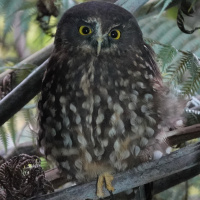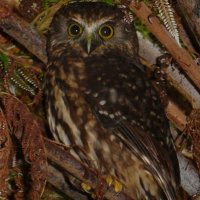Introduction
The Morepork is a medium-sized owl with a rounded head and no ear-tufts. Its name is derived from its well-known double hoot call. It is also known as the Ruru or New Zealand Boobook.
Photo Gallery (3 pictures)
Sound Gallery
Information
Description: There are many colour morphs, with considerable variation in plumage.
The facial disc is dark brown with a pale buff rim, and with narrow whitish eyebrows. The eyes are bright golden-yellow, and the bill is dark with a pale tip.
Upperparts are dark brown, with ochre-buff mottling and streaks on the head, neck and mantle. Wing-coverts and scapulars are spotted cinnamon-buff and
whitish-buff. Flight feathers are dark to blackish-brown, with narrow cinnamon-buffish bars. The tail is dark brown with narrow ochre or buffish bars.
The throat to the upper breast is brownish-white to pale buff with dark chocolate-brown flecks and streaks. The rest of the underparts have spotted feathers,
with each feather whitish, with a dark shaft-streak and a dark terminal bar.
Tarsi are feathered yellowish-brown to reddish-buff. Toes are yellow to brownish-yellow and normally bristled, but occasionally bare. Claws are dusky brown to
blackish.
Size: Length 26-29cm. Wing length 183-222mm. Tail length 135-146mm. Weight 150-216g. Females are usually larger and heavier than males.
Habits: This owl is commonly seen at dusk, when it begins hunting. Roosts during the daytime in dense canopies or in a tree-hole.
Voice: The characteristic call is an individually variable double-hoot "Quor-quo", or, as the name suggests "More-pork" at a similar pitch to a dove's call. These notes are repeated at intervals of several seconds. A common variation is a repetitive and often prolonged "more-pork-pork-pork...". There is also a scream and a vibrating "cree-cree", heard mainly in the breeding season.
Hunting & Food: Hunts from early dusk, and takes mainly insects including moths and beetles, as well as spiders. Prey is caught from a perch or hawked in flight. Other prey items include lizards, small birds, rats, bats and mice.
Breeding: Laying begins in early October, with a peak in November. Nesting sites are in hollow trees, tree holes, or dense clumps of
vegetation, and sometimes in a tree fork, or even in a depression of on top of an old sparrow nest. Two, occasionally three roundish white eggs
(38.0 x 32.7mm average) are laid at a two-day interval and incubated for 30-31 days by the female alone, while the male provides the food. Both parents feed the
chicks after they hatch. Chicks leave the nest by 34 days old, and are cared for by both parents for some time afterwards.
Sexual maturity is reached in the first year, but normally males will breed at the age of two years, and females three years.
Habitat: Forest and farmland, also urban areas and plantations. Ranges from lower altitudes up to the timberline.
Distribution: New Zealand and surrounding islands. Also on the distant Norfolk Island, north of New Zealand. Probably extinct from Lord Howe Island.

Range of the Morepork Ninox novaeseelandiae
Status: Not uncommon. Listed as 'Least Concern' by Birdlife International.
Original Description: Gmelin, Johann Friedrich. 1788. Systema Naturae, 1, Pt.1, p. 296.





